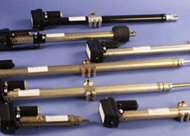As a crucial area of science, mechanical energy is making its presence felt through varied industrial applications every day. Linear actuators have become source of exploration for science and engineering enthusiasts, mostly because of their versatile ways of functioning. Linear actuators are industrial devices that generate mechanical motion in a straight line by converting energy from any source. In present days, linear actuators are also being used for varied medical purposes.
How do the Liner Actuators Works?
This mechanical apparatus derives energy normally generated by air, liquid or electricity, in order to transform that into a form of motion (ideally linear). This created motion can relate to clamping, blocking and ejecting. The device works as a motor runs to rotate a screw-drive coordinating with a timing belt drive. Some linear actuators work by using worm gear drive or direct drive. Irrespective of the type, the drive nut is pushed by the turning of the screw, which is turn pushes the rod back and forth. Ideally the screw-drive is either an ACME or belt-driven that provides motion to the machine.
The screw nut comes with a cover tube that protects it from environmental elements and contamination, which allows for a long-lasting usage of the actuators. Another important component in a linear actuator is the radial thrust bearings. This allows the screws to freely rotate under pressurized conditions, and also gives strength to the industrial linear actuator. Linear actuators play a significant part in motion control systems
The most common forms of energy that operate actuators are hydraulic, pneumatic, mechanical and electrical. When it comes to factory automation and robotics, linear actuators are widely used.
Things to Know Before Using a Linear Actuator
For a customer, it is important to know in and out about linear actuators and their operational features and types before choosing a specific design. After all, the particular type is expected to meet the required applications and purpose of the project. Certain factors should be taken into consideration when it comes to linear actuators, and these are, stroke length, speed and load rating of the actuator. Apart from that, programmability of linear actuators is also a preferred factor when the application in question requires specialized detail and precision.
A linear actuator can basically be used for a wide range of applications ranging from domestic, commercial to industrial. It is hence important to know how they operate and how to use the mechanism safely yet efficiently.

